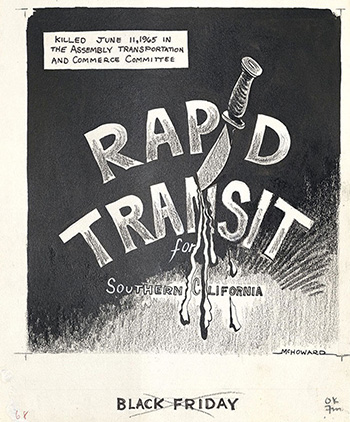Newsletter Edition: Spring 2021
Contributed by Kathy Dabbour
For its first all-virtual exhibition, the Special Collections & Archives department presents, Los Angeles: On Film and On Record, now through July 30, 2021, which examines a selection of popular films that feature Los Angeles in the storyline and/or setting, and using film clips and digital images of archival and other primary sources, compares their vision to the documentary record of the “real” Los Angeles. Since opening August 22, 2020, the exhibit has had over 3,000 views. In keeping with its virtual genre and the Library’s support of student learning, the exhibit includes links to podcasts created by English students focusing on specific films in the exhibit for their final research assignment in their Honors Seminar class.
The Los Angeles On Film and On Record exhibit was curated by the three archivists in Special Collections & Archives (SCA): Mallory Furnier, April Feldman, and Julieta Garcia, and what follows summarizes their responses to interview questions about the making of the exhibit.

What was the inspiration for choosing the theme of the exhibit, and what came first, the movies or the archival collections held by SCA?
SCA chooses the general themes for their annual exhibits several years in advance, which is based on their archival holdings. This year’s exhibit was listed as a “Los Angeles exhibit,” and the idea for using film came up organically. The curators investigated themes from several Los Angeles-based films and identified which of SCA’s archival collections could potentially be tied in. While they did their best to incorporate films that are the most well-known, the curators had to match the chosen films with relevant archival collections. Therefore, they had to exclude some obvious Los Angeles themed films, such as Pulp Fiction, Ed Wood, and Big Lebowski since Special Collections & Archives did not have collections that fit their theme.
How was the virtual exhibit created and what were the roles of the curators and others who put it together?
Originally, LA on Film was supposed to be a physical exhibit, with stills from the film displayed alongside archival materials. However, in March 2020, it became evident that the exhibit would have to be virtual. Each of the three archivists assigned to curate the exhibit was responsible for researching and selecting three to four Los Angeles-themed films along with relevant archival materials from SCA’s collections, and writing the descriptive text that accompanies the images. As usual, relevant collections were located in the Library’s Automated Storage & Retrieval System (ASRS) and retrieved by Tony Ivankovic, ASRS Supervisor, and other Guest Services staff, who worked out a physically distant and safely handled process for getting the materials to the archivists while the Library remained closed. Ellen Jarosz, Head of Special Collections & Archives, and Holli Teltoe, former SCA Coordinator, proofread the entire exhibit’s text copy. The Library Web Services Coordinator, Elizabeth Altman, and Guillermo Flores, Web Programmer, created the exhibit’s webpages.
What activities were students assigned related to the exhibit and what impact did they have on the current or future exhibits? What kind of feedback did you get from the students and professor?
English professor, Dr. Colleen Tripp, collaborated with the LA on Film exhibit curators to construct a research assignment for her fall 2020 English 492 honors seminar for which students created podcasts to be linked to the films they studied in the virtual exhibit. The podcast assignment worked so well that Dr. Tripp expanded it to her spring 2021 capstone seminar class, and the curators were invited to discuss the process of mounting the exhibit with her class. After attending Dr. Tripp’s class, it was clear to the curators that the students were excited to work on something similar and were impressed with the exhibit.
What do you think are the advantages and disadvantages of an online exhibit? Which type is harder to do and/or has the most impact on the viewer—virtual or physical—and which do you prefer as a curator?
Creating any type of exhibit takes a lot of work, from curation to web development to marketing and event planning. For previous in-person exhibits, online walking tours of the exhibit mounted in the Library Gallery were created. This time, with the entire exhibit online, which was a first for SCA, it was more challenging. However, with the Library closed due to the pandemic, the advantages of a virtual exhibit are clear. It was also advantageous for displaying archival resources and specific film clips side-by-side. The only disadvantage was the learning curve and time constraints required to switch to planning and executing a virtual exhibit. On the other hand, being virtual allowed student involvement through an engaging medium, Podcasting, which encouraged more student interest in the exhibit than it perhaps would have received as a physical exhibit.
